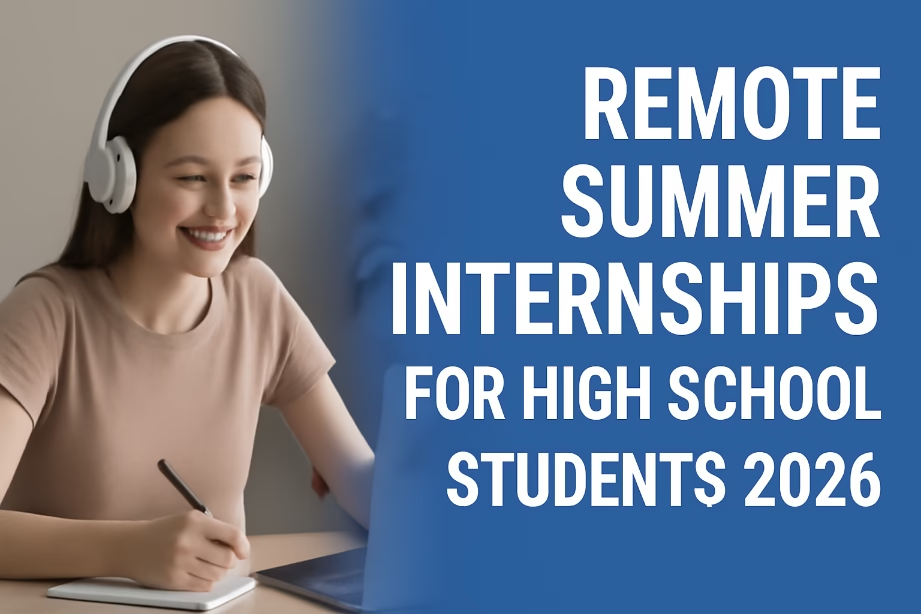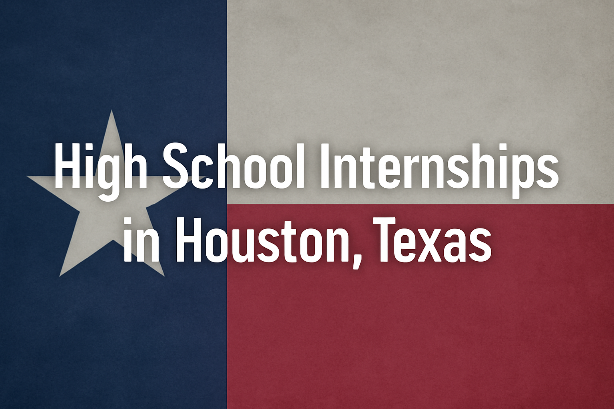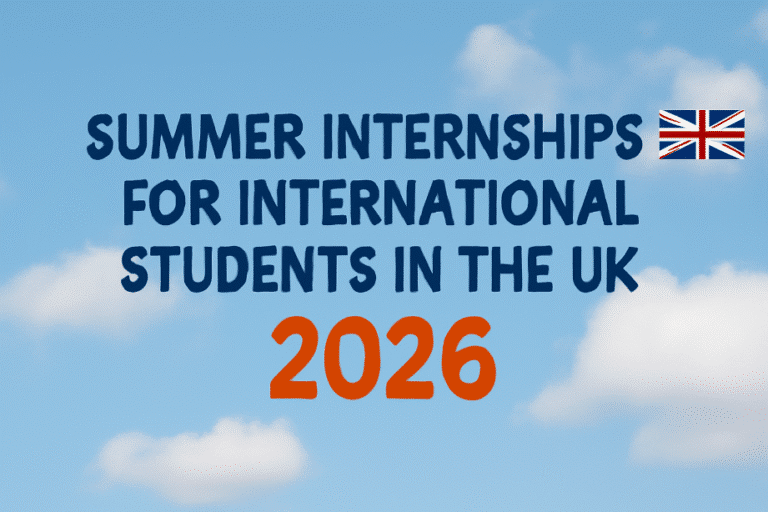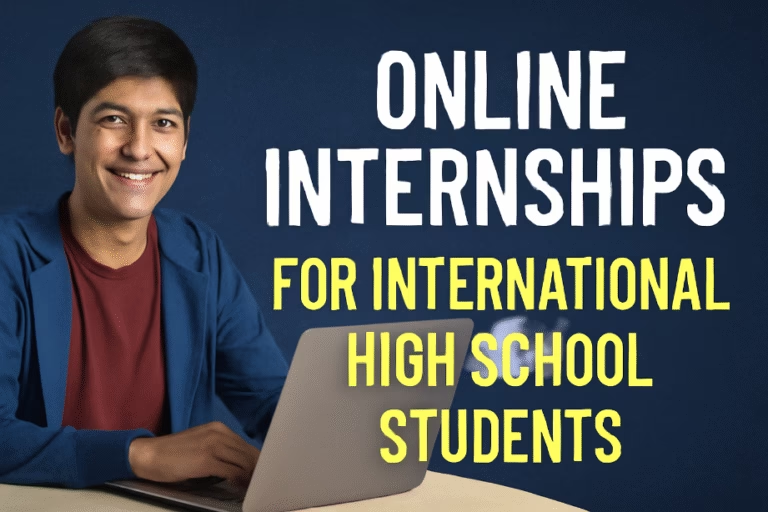15 Best Remote Summer Internships for High School Students 2026
Remote Summer Internships for High School Students 2026
Remote summer internships have become a mainstream and highly effective way for high school students to gain meaningful experience without the expense or logistics of travel. For 2026, the options span research projects, tech internships, data science, bioinformatics, energy policy, open-source software, and micro-internships that pay. This guide curates the top remote summer internships and programs suitable for motivated high school students, with clear notes on eligibility, costs or stipends, location (remote), and typical application windows. Each listing links to an official program page or authoritative source so you can investigate current cycles directly.
Why remote summer internships matter in 2026
Remote internships allow students to:
- Work with mentors and teams worldwide without relocating.
- Build portfolio projects (code repositories, research posters, design prototypes).
- Develop remote collaboration skills employers and universities seek.
- Access opportunities that were previously regionally restricted.
This post lists 15 vetted programs that routinely offer remote summer internships or research experiences appropriate for high-school learners. It also includes application strategy, sample timelines, what to include in your application, and an FAQ section answering common visa, funding, and competitiveness questions.

Top remote summer internships
-
1. NASA High School Aerospace Scholars (HAS) — virtual tracks
Official link: NASA HAS
Description: NASA’s HAS includes online modules, virtual team projects, and live sessions with NASA engineers. Though HAS often integrates in-person capstones for selected students, most instruction and project work are fully remote—making it ideal for students who want aerospace exposure without travel.
Requirements: Varies; certain tracks have U.S. residency/citizenship rules—check the official page.
Paid/Unpaid: Educational program (unpaid).
Timeline: Application windows typically open in winter/spring for summer sessions.
-
2. Johns Hopkins — Virtual STEM & Research Modules (Pre-College)
Official link: Johns Hopkins CTY / Pre-College
Description: Johns Hopkins’ pre-college and CTY initiatives periodically offer short, mentored virtual research experiences in neuroscience, data science, and biomedical topics. Students produce lab-style reports and present to mentors at program close.
Requirements: Competitive academics; grade-level requirements vary by module.
Paid/Unpaid: Typically fee-based for pre-college; selective scholarship slots may exist for research cohorts.
Timeline: Applications usually open autumn–winter for summer participation.
-
3. NASA GeneLab for High Schools (GL4HS) — bioinformatics internships
Official link: NASA GeneLab
Description: GeneLab runs virtual cohorts that teach genomics and data analysis using real spaceflight-derived datasets. Students learn R/Python workflows and produce reproducible analyses that contribute to mission science.
Requirements: High school juniors/seniors with background in biology or programming preferred.
Paid/Unpaid: Often free; certain cohorts may include stipends for selected participants.
Timeline: Seasonal cohorts with deadlines in spring; check GeneLab education pages.
-
4. Veritas AI — Remote AI/ML internship pathways for teens
Official link: Veritas AI
Description: Veritas AI provides structured remote internships and projects in machine learning, data science, and applied AI for motivated high school students. Projects include mentor sessions, model-building tasks, and portfolio-ready artifacts.
Requirements: Basic programming (Python) recommended; applicants should demonstrate interest through coursework or projects.
Paid/Unpaid: Fee-based for some cohorts; scholarship assistance sometimes available.
Timeline: Cohorts run throughout the year; summer cohorts fill in late winter.
-
5. The Forage — Employer-designed virtual work experiences
Official link: The Forage
Description: The Forage offers self-paced virtual “work experiences” designed by employers (engineering, product, data). These simulate real tasks and are excellent for high school students to demonstrate applied skills; many companies accept Forage completion as part of hiring consideration.
Requirements: Open to high school students; self-paced format suits beginners.
Paid/Unpaid: Free; certificate of completion.
Timeline: Available year-round — enroll anytime and complete modules over the summer.
-
6. Outreachy — open-source remote internships (where eligible)
Official link: Outreachy
Description: Outreachy places participants in open-source engineering projects with remote mentorship and paid stipends. It targets underrepresented groups in tech and accepts applicants internationally. Note: applicants must be 18+; older high school graduates and gap-year students are commonly eligible.
Requirements: 18+, belonging to eligible groups; application requires project proposals and past contribution examples.
Paid/Unpaid: Paid stipend (amount varies by cycle).
Timeline: Twice yearly cohorts; apply when calls open (check the Outreachy calendar).
-
7. Google Summer of Code (GSoC) — student open-source internships
Official link: Google Summer of Code
Description: GSoC pairs students with open-source organizations on remote coding projects. Eligibility historically focuses on college students, but some cohorts/program adaptations or affiliated programs accept high-school-aged contributors (often 16+). It’s an outstanding way to get paid for a remote coding project.
Requirements: Age/eligibility vary; review the year’s rules carefully.
Paid/Unpaid: Paid stipend on successful completion.
Timeline: Annual schedule — applications open early in the year for summer work.
-
8. CodeDay Labs — remote software engineering internships for teens
Official link: CodeDay Labs
Description: CodeDay Labs runs mentored, cohort-based remote internships where teens contribute to open-source projects or build tools under mentorship. Outcomes include published projects and mentor letters.
Requirements: Some coding experience recommended; beginners with strong motivation can be accepted.
Paid/Unpaid: Typically free or low-cost; occasionally scholarships are available.
Timeline: Multiple project cycles across the year; summer cohorts available.
-
9. Ladder & Ladder-style cohort internships — remote startup projects
Official link: Ladder Internships
Description: Ladder runs cohort-based remote internships in product, data, and engineering where participants work on real startup projects with mentor feedback and a final “demo day.”
Requirements: High school or gap-year students with some background or demonstrated interest.
Paid/Unpaid: Some cohorts are paid; others are fee-based with guaranteed outcomes.
Timeline: Cohorts run year-round including summer intensives.
-
10. Columbia University Virtual Summer Research Assistantships
Official link: Columbia Pre-College & SPS
Description: Columbia’s School of Professional Studies and departmental outreach programs sometimes offer virtual research assistant roles for high-achieving high school students in data science, public health, and engineering research.
Requirements: Selective; strong academics and a clear research interest help.
Paid/Unpaid: Varies — some opportunities include stipends or scholarships.
Timeline: Applications usually open in winter for summer placements.
-
11. Smithsonian Virtual STEM & Digital Learning Labs
Official link: Smithsonian Learning Lab
Description: The Smithsonian runs virtual research and digital curation modules in conservation, natural history, and data analysis. Projects include mentor interactions, archival research, and data visualization.
Requirements: Open to high school students for many modules.
Paid/Unpaid: Mostly unpaid educational modules; some award scholarships for intensive cohorts.
Timeline: Rolling module availability; formal summer programs listed annually.
-
12. Energy & Climate Remote Internships — Government and NGO projects
Where to look: U.S. Department of Energy student programs, energy think tanks, and climate NGOs periodically offer remote analysis or policy internships suitable for high school students.
Description: Tasks include literature reviews, data visualization, policy briefs, and model-building under mentor supervision.
Requirements: Interest in climate/energy policy and basic data skills.
Paid/Unpaid: Mixed; certain government or funded NGO projects provide stipends.
Timeline: Summer cycles posted in spring; check DOE and NGO career/education pages.
-
13. Virtual Student Federal Service (VSFS) — remote projects with US agencies
Official link: VSFS
Description: VSFS connects students with U.S. federal agencies for remote projects in data science, engineering communications, GIS, and scientific research. While many roles target college students, occasionally opportunities suitable for advanced high-schoolers appear.
Requirements: Often U.S. citizenship required; eligibility varies by agency.
Paid/Unpaid: Unpaid (volunteer), but provides high-value references and experience.
Timeline: Annual call for projects — check the VSFS portal for announcements.
-
14. Micro-internships & Project Marketplaces (Parker Dewey, similar platforms)
Examples: Parker Dewey (micro-internships), freelance marketplaces, and student-focused micro-intern platforms often list short, paid remote projects that high school students can complete in weeks.
Description: Short assignments (data cleaning, market research, basic coding, design tasks) that pay hourly or per project. Excellent for building portfolio and earning income over the summer.
Requirements: Varies by project; many are accessible with basic skills and good communication.
Paid/Unpaid: Paid — variable rates depending on task complexity.
Timeline: Rolling; projects posted throughout the year and spike in summer months.
-
15. Oxford Scholastica / Oxford Remote Research Internships
Official link: Oxford Scholastica
Description: Oxford Scholastica and similar university-affiliated academies offer four-week remote research internships with academic mentors and a final research paper or presentation suitable for publication or university referrals.
Requirements: Ages typically 15–18 with strong academic records and research interest.
Paid/Unpaid: Fee-based; scholarships and bursaries sometimes available.
Timeline: Sessions in July–August; deadlines in spring.

How to pick the right remote summer internship
Choosing the best remote internship depends on your goals. Follow this simple prioritization:
- Project outcome: Prefer internships that produce a deliverable (code, poster, report) you can add to your portfolio.
- Mentorship frequency: Programs with weekly mentor check-ins provide faster learning and stronger recommendation letters.
- Time commitment and scheduling: Ensure the weekly hours fit your summer plans (most remote internships expect 5–20 hours/week).
- Cost vs. value: Free or stipend programs provide clear financial value; fee-based programs can still be worth it if mentorship and outcomes are strong.
Application checklist & timeline (sample)
Below is a compact timeline and checklist to help you apply for summer remote internships (assumes a June start):
- September – November (prior fall): Research programs, shortlist 5–8 fits; begin portfolio work (GitHub, project PDFs).
- December – February: Draft application essays, request 2 recommendations (teachers or mentors), complete any prerequisite coursework.
- March – April: Finalize applications; submit before deadlines. Prepare for potential interviews (technical or behavioral).
- May – June: Accept offers, set up workspace (reliable internet, background for video calls), complete pre-internship onboarding tasks.
What to include in your application
- Short resume (1 page): Highlight relevant coursework, coding projects, clubs, competitions, and part-time work.
- Project samples: Links to GitHub repos, research abstracts, posters, or brief code walkthroughs.
- Personal statement: 300–500 words outlining what you hope to learn, a concrete project idea or past project example, and why the internship fits your trajectory.
- Recommendations: One teacher or mentor who can speak to your technical promise and work ethic.
- Availability: Clear weekly hours you can commit during the summer.
How to stand out (tips from mentors)
- Include deliverables: If you’ve built even a small project, include a 2-minute readme describing goals, challenges, and results.
- Be proactive in interviews: Offer a one-page plan of the first 3 weeks of work—mentors love initiative.
- Show collaboration experience: Mention any group projects, hackathons, or club leadership that demonstrates teamwork.
- Ask thoughtful questions: During interviews, ask about mentor involvement, expected deliverables, and prior student outcomes.
Deliverables you should aim for by the end of a remote summer internship
- Working code pushed to GitHub with a clear README and usage instructions.
- A 1,000-1,500 word research summary or technical blog post describing methods and results.
- A final slide deck or video demo presented to mentors and stored in your portfolio.
- One or two letters of recommendation or mentor endorsements for LinkedIn/college applications.
Frequently Asked Questions (FAQs)
1. Are remote summer internships competitive?
Yes. High-quality remote internships (NASA modules, university research assistantships, organized cohort programs) are competitive because they combine mentorship with tangible outcomes and are accessible to geographically diverse applicants. Apply early and present clear project evidence.
2. Can international students apply?
Most remote internships accept international applicants unless the program has citizenship/residency requirements (e.g., certain government projects). Open-source programs like Outreachy and many private providers are global — check eligibility on each program page.
3. Do remote internships provide stipends or pay?
It varies. Outreachy and Google Summer of Code provide stipends. Micro-internships and some NGO or government-funded projects may provide small stipends. Many university pre-college programs are fee-based rather than paid; weigh cost against mentorship and outcomes.
4. How many hours per week should I expect to commit?
Most remote summer internships expect between 5–20 hours per week. Bootcamp-style intensives may ask for 20–40 hours per week for short durations. Verify the time commitment before accepting to avoid conflicts with family or travel plans.
5. How do I avoid scams?
Red flags include: unsolicited offers without application, requests to pay large fees with vague refund policy, email addresses from generic domains (not official orgs), and employers who insist on immediate payment for “processing” without clear program documentation. Use reputable aggregators, university pages, and official organization links. Ask for references from prior participants when in doubt.
6. Can remote internships turn into further research or paid work?
Yes. A strong remote internship can lead to extended mentorship, follow-on research projects, freelance micro-tasks, or introductions to college research groups and startups that may offer paid roles later.
Closing notes & next steps
Remote summer internships are one of the most practical ways to build skills, clarify academic interests, and prepare a compelling college or scholarship application. Start by shortlisting 3 programs from this page that match your interests and availability. Prepare a compact portfolio, request recommendations early, and allow time for interviews.










One Comment